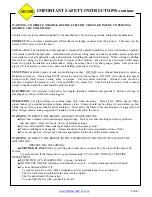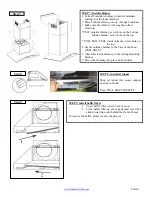
www.XtremeAirUsa.com
PAGE
4
HEIGHT &
CLEARANCE
VENTING METHODS:
VENTING REQUIREMENT
IMPORTANT:
•
NEVER exhaust air or terminate duct work into spaces between
walls, crawl spaces, ceiling, attics or garages.
All exhaust must be
ducted to the outside.
•
Hood mounted too low could result in heat damage and fire hazard;
while hoods mounted too high will be hard to reach and will loose its
performance and efficiency.
•
Use metal duct work only
. Rigid metal vent is recommended. A
minimum of 6” round (standard for this range hood, purchased
separately must be used to maintain maximum airflow efficiency
•
DO NOT use plastic vent.
•
DO NOT use 4” (10.2 cm) laundry-type wall caps
•
Fasten all connections with sheet metal screws and tape all joints with
aluminum tape.
•
Use caulking to seal exterior wall or roof opening around the cap.
•
The vent system must have a damper. If roof or wall cap has a damper,
do not use damper supplied (for some models only) with the range
hood.
For the most efficient & quiet operation:
•
A distance of 26” to 30” is recommended between stove top and the
bottom of range hood.
•
It is recommended that the range hood be vented vertically through
the roof through 6” or bigger vent work.
•
ALWAYS, when possible, reduce the number or transitions and turns.
If long duct run is required, increase duct size from 6” to 7” or 8”. If a
reducer is used, install a long reducer instead of a pancake reducer.
Reducing duct size will restrict airflow and decrease airflow, thus
reduce duct size as far away from opening as possible.
•
If turns or transitions are required: Install as far away from opening
and as far apart, between 2, as possible.
•
The size of the vent should be uniform.
•
Use no more than three 90° elbows.
•
Make sure there is a minimum of 24” (61 cm) of straight vent
between the elbows if more than one elbow is used.
•
DO NOT install two elbows together.
02
04
03
































